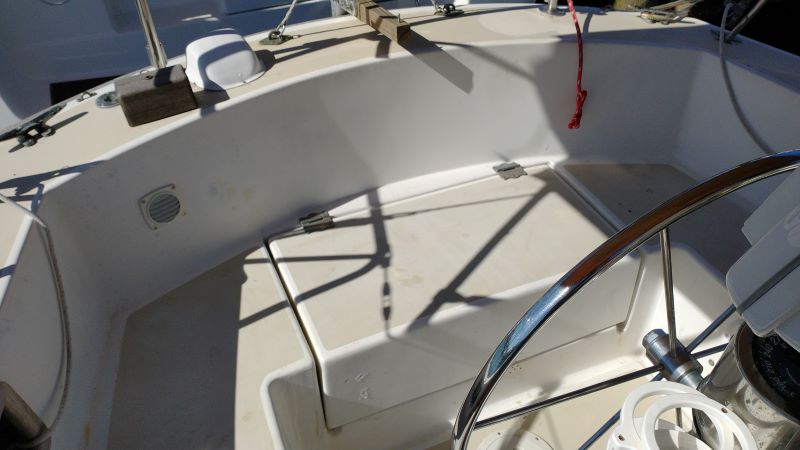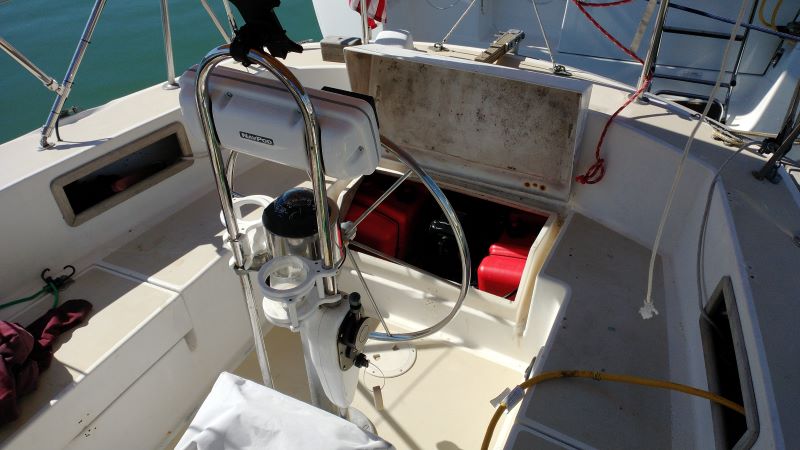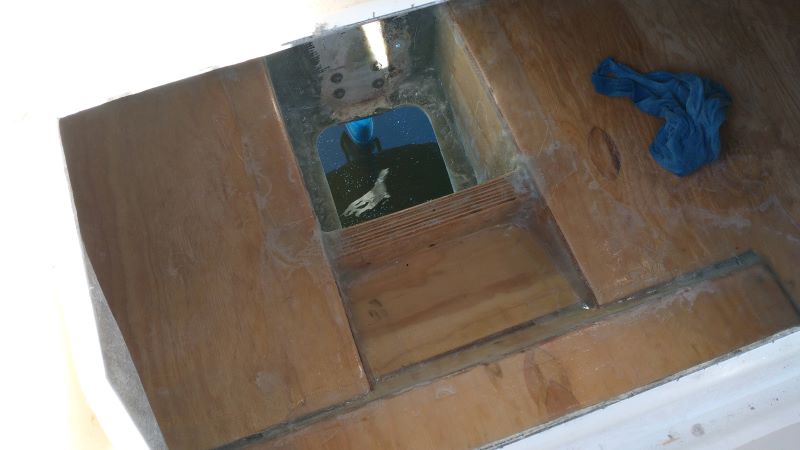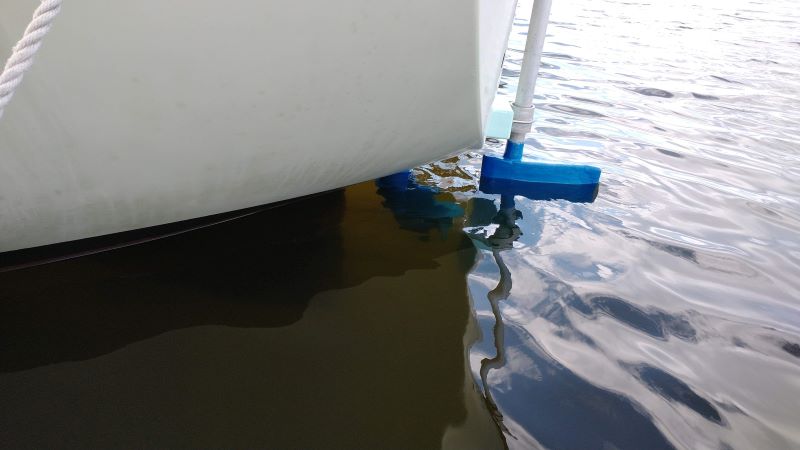Pearson 365 Hybrid Gas Outboard Well / Electric Inboard
Until meeting Chris and Valerie when they visited Brunswick with their electric inboard propelled Pearson 365 in December 2020, I hadn’t given much thought to the advantages of having a combined outboard motor well and an electric inboard motor propulsion system. While laying over in Brunswick on the way south for the winter they decided to increase their motoring range during calms offshore and when travelling the ICW by constructing a non-tilt outboard well (with option to make it tilt up later). Range restriction is always an issue with pure EP on any cruising yacht that ventures beyond home waters. The common fixes for that are to install a diesel generator on larger yachts or place a portable gas generator on deck to run a battery charger that typically only has enough output for very slow speeds. Adding an outboard well on suitable boats seems a big advantage over either of the other options and adds redundancy to a complex EP system that has several points of potential failure of electronics at sea. The downside with dual propulsion systems is you have the extra expense, weight and space required, and until Chris modifies the well so that it that allows the motor to tilt up when not in use, he is dragging the prop when sailing. Below is an update I received from Chris after they tested out the modification as they travelled south through Florida:
After living with the “inboard-outboard” motor well setup on our Pearson 365 for a while and a couple hundred miles I’m ready to offer a verdict: I love it, but with reservations for a boat this big. A bit of background: Our boat came to us with just an electric inboard installed by a previous owner as auxiliary propulsion when we bought it. It is an electric yacht 15kW (72V air-cooled) installation powered by (12) 200AH 6V flooded cells wired for 200AH at 72V installed where the diesel used to live. This motor drives an 18” folding prop and is rated at approximately 20 HP, which is adequate in terms of emergency power and marina / channel use on our 19k lb boat. Range, of course, is pretty terrible when compared to an inboard burning dinosaur juice and highly dependent on speed. Estimating EP range with 50% battery bank discharge is very hard to do accurately since my battery bank is flooded lead acid. Peukert’s law being what it is, the bank is discharged rapidly by higher power draws so I just don’t really use it that way. We use the EP for marina entry, getting through bridges, channel currents, etc. That said, I will estimate that 50% discharge gets 15 miles @ 3 knots, 6 miles @ 4 knots, and 4 miles @ 5 knots. And, then you have to sit there with a generator running for 8 hours to recharge. I’m actually not a fan of EP as the only auxiliary solution unless people really are sailing purists and then they would probably want a boat that moves better in light air than a Pearson 365. Some electric boat users try to augment range with a generator-charger-EV setup, but inefficiencies and single-point failure modes were a concern I had. Also, this practically limits one to about 1hp in constant use or around 2-3 knots.
After reading through the conversions you’ve done, I bit the bullet and converted the lazarette locker into a fixed motor well, with the possibility of upgrading it to a tilt-up well later if desired. That is, the mounting bracket location for the motor works with either option. I chose to start with fixed for a few reasons. Primary of these is that I already have an auxiliary rudder / self-steering system bolted on centerline on the transom that would need to be moved.
Engine choice came down to one of 2 options: Tohatsu 6hp Sail Pro or a Yamaha T9.9. The Yamaha makes close to 2x the bollard thrust and would cruise quieter with less vibration and at least 5 knots in the calm according to Dave Gerr and his “Propeller Handbook” calcs. The Sail Pro is lighter, cheaper, and has a smaller propeller to drag since this is a fixed non-tilt. Most importantly for my conversion, I determined that I could just get the Tohatsu into and out of the well by myself without throwing out my back. And I didn’t have to cut into the cockpit seats / bulkhead to accommodate the raised motor head when it tilts up and forward. It also allowed me to stick a 12-gallon gas tank on both sides of the motor with adequate clearance to fuel them and have slight ability to turn the motor for side thrust.
So, how does it perform? Well, both worse than a diesel and better, as with everything boat. For the worse, it’s pretty obvious:
- I can make about 4-4.3 knots in the calm at WOT and that will probably drop to 0 in 25 knots headwinds. This isn’t for punching into waves. Motoring in the ICW is annoying so we try not to do that much, but it is feasible.
- Noise is buzzier at WOT than a diesel. However, it’s compartmentalized away so I prefer that. I’d say more annoying at the helm, but much better down below.
- Gasoline is more dangerous than diesel, but I sealed the lazarette fully from the rest of the boat with plywood and fiberglass bulkheads so that’s as reasonable as I can make it. The locker is vented both high and low so no vapors can accumulate.
- Some loss of reserve buoyancy in the stern. I made the actual motor well pretty tall and narrow to try to fight back on this. The fuel tank platforms slope to the center about 5 degrees and all water that may splash up can drain right back out the hole. I’ve yet to see water actually splash outside the motor well in practice but I’m sure some big wave will get there.
- A bit extra drag on the motor hole as I haven’t made up boards to close that off around the motor skeg yet. Easy upgrade one day when I’m bored.
- 6hp isn’t really safe enough to enter many channels in currents or waves or try to get out of scary situations under power alone. We fall back on the EV inboard for these scenarios. I don’t think I’d be comfortable with the Sail Pro without this hybrid setup.
- The fixed (vs tilt-up) motor does have some drag. I’m pulling an 8.3” diameter prop through the water vs the 16” fixed prop many boats this size might use. ¼ the area, ¼ the drag. In practice, I think I lose about 0.2 knots vs. a tilt up.
- The fixed motor will have higher corrosion and fouling growth. I painted the lower leg with antifouling and expect reduced life. I consider this a “poor man’s saildrive” and expect similar hassles at a lower cost.
For the pros:
- I absolutely love the maintenance aspect. My worst-case scenario is to buy another outboard every 5 years, when the warranty is up. I can fully remove and reinstall the outboard in 20 minutes so everything is easy work. I’ve never had a newer, reliable diesel in the price range of boats I shop so there’s some bias there.
- Tons of space inside the boat that isn’t relegated to the diesel bits. Currently, it’s full of batteries, but that’s just what came with the boat. Eventually, I’ll cut the EV pack size in half and repurpose that space.
- Our boat smells clean without the diesel. I’m particularly sensitive to diesel smell, I think.
- Motor-sailing in light air works really well. We usually keep the outboard at low throttle and just use it to keep up momentum and to keep the autopilot on track. Fuel burn is very low as the sails are still doing most of the drive this way.
- Pure motoring in the calms works pretty well at reduced throttle. We forget the engine is on and although we are only going ~3.5 knots, that still adds up to 75+ miles in a day. There is nothing wrong with operating a small engine at moderate load for extended periods of time. Consider the Honda EU2000i as proof of this point. Change the oil once a week, but otherwise it’s fine. Operating it at WOT for a week straight would hurt the reliability. I’m an engineer with a background in engine design so speak from some experience here.
- We actually have (3) completely isolated motoring solutions (Sail Pro, EU2000i to EV charger, and dinghy outboard). The spare part volume and cost for an outboard are much lower than an inboard diesel. Maybe once my 5-year warranty is up, I’ll replace it and keep key parts off the old one. Oh, and we have those sails of course.
- Range is, surprisingly, not worse than the diesel, but it’s delivered differently. A doubling of speed from 3 to 6 knots requires 6x the power to the propeller. Since a diesel will actually be ruined by running long periods at 3 knots (unburned fuel will lead to cylinder wall glazing), it has to run up closer to 6 knots. That means that the efficiency of the big diesel is overcome by the higher fuel burn to go faster, while the little Tohatsu is perfectly happy to run at 3 knots all day long. In the end, mpg can be higher on the gas outboard as long as one is willing to go slower. Put another way, the little gas outboard is more optimized for the more efficient slow speed operation if that’s the goal. So, on this boat one gallon of diesel should give 12 mpg at 4 knots and we get 12 mpg at 3 knots with the gas outboard. It takes a different way of thinking of range. At lower throttle I can get 15 mpg on the Tohatsu and so the range is about 450 miles @ 2.6 knots in the calm. Our fuel budget is a joke.
- At some point, I’m going to get the cockpit to drain into the lazarette locker in an emergency. This would dwarf the current cockpit drain flow rates.
- I’ve had outboards on brackets off the transom on 30+ ft boats in the past and absolutely hated them. In the water only half the time, ugly as sin, scary to adjust in any chop… the well is the way to go.
The attached photos show the outboard engine installed along with the fuel tanks either side. There’s just enough room to get in there and fill them. Plenty of storage space for light bulky stuff outboard of the fuel tanks (some insulation foam, pool noodles for our float chair, spare life vests, etc. This both adds buoyancy in a pinch and reclaims some lost space. There is just enough clearance to get that motor cover off for service and so far I haven’t seen it come close to dunking.
Note, I made this a “double-wall” hermetic seal below the waterline. There is an entire glassed-off bulkhead underneath what can be seen in the photo here in case I get a leak around the motor well. Since I cut the hole with the boat in the water, I figured this may be reasonable insurance!
The outboard fits in-line between the main rudder and the backup rudder / autopilot spade rudder I built. The propwash doesn’t add any noticeable vibration and really increases the responsiveness of the autopilot when motoring. The actual prop is about 2’ below the surface and I haven’t heard it cavitate once since doing this project I’m happy to report.
I wouldn’t have done this without the electric inboard for the emergency power and control, but feel this was a good call for a “hybrid” setup to get the range the electric lacks. I think the hybrid EV inboard / outboard well is a viable way of extending the “inboard-outboard” to boats up to perhaps 40’ LOA for people who can accept the reduced motoring speed in return for simplicity. I’m certainly happier than when the boat was purely electric and I say that as an EV fan.





